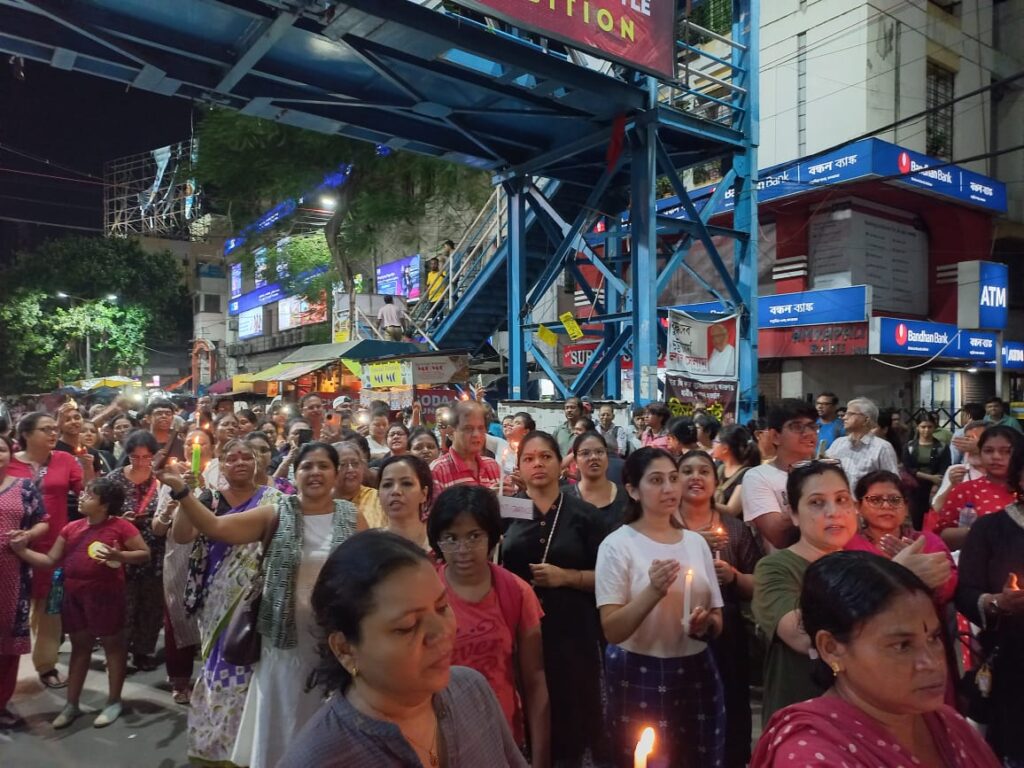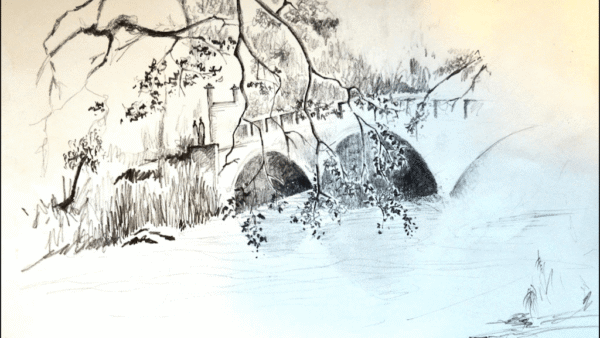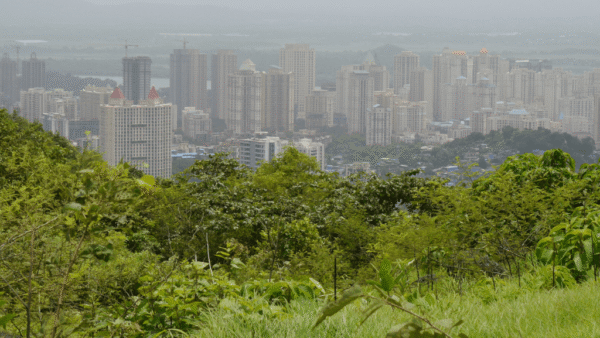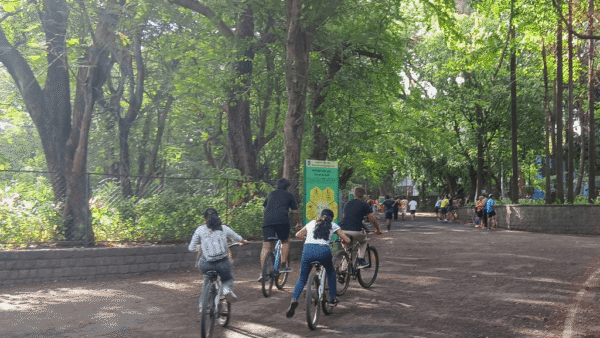At a late evening walk down Rabindra Sarovar, participants of our Gender Community Walk group stood still to appreciate the sunset and the tranquility far removed from the bustle of traffic. We heard only the sound of cooing birds, rippling water of the massive Dhakuria Lake, relaxed voices and leisurely footsteps. This is one of the most integral urban commons of Kolkata[1], an ecological common that brings communities together, creating a balance in the anthropocentric city life.
Yet, from a gendered semiotic lens, the common resource showed many privileges and deliberate exclusions about temporality and access for women and queers. We noticed, especially after dark, men in large numbers entering, the spaces around the Lake feeling quieter, lighting done indifferently that made us uncomfortable. We had, that March evening, a consistent visceral feeling of being watched – and of not belonging in these commons. This made us question the kinds of access different people have to common spaces in cities, and wonder where women or queers belong.
Of course, public spaces are shaped according to ideologies and intent – how we conceive them, how we perceive them, and how we live through them – constructing the triad of spaces concept by French sociologist Henri Lefebvre[2], making us the accountable actors (Schmid, 2022). While spaces are constructed, our use and perception of them varies too. They are either stigmatised according to the identities of who occupies them or called unsafe based on the incidents that occur in them.
The present neo-liberal approach of dividing cities into zones of profit[3], consumption, and class has not really helped because it has alienated individuals from one other. These are examples of how cities are being relentlessly constructed with a lens that prioritises profit over partnership, concrete over co-existence, and steel against ecological stability. Privatised spaces also place a high value on anonymity and, possibly, a lack of accountability. All this, coupled with varied use, lighting and safety creates unequal access for gendered bodies. The infrastructural commons are shaped by social models of behaviour, customs and norms.
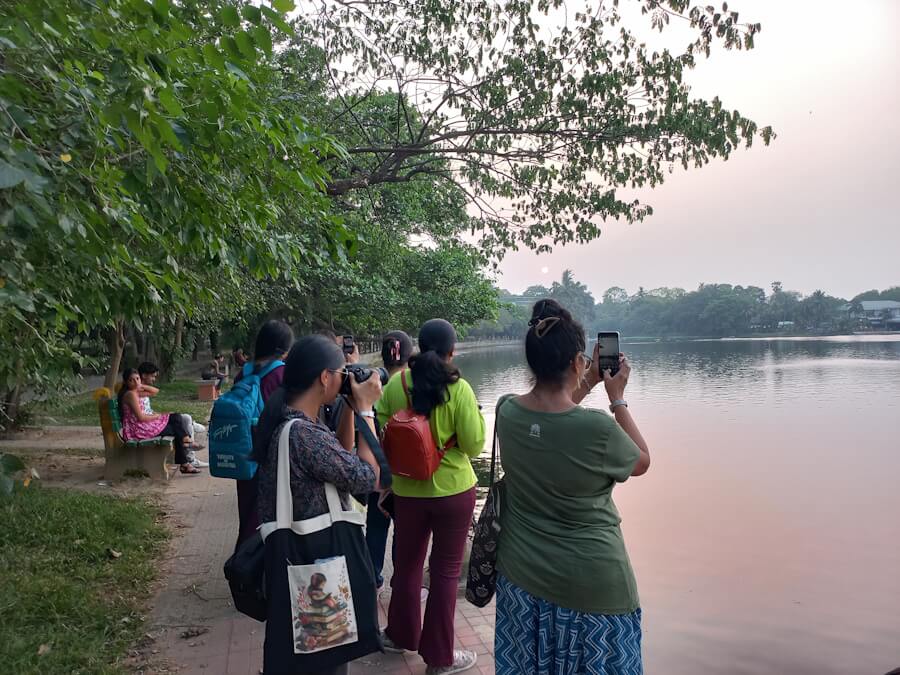
Photo: Srestha Chatterjee
Rights are not merely about having a political voice in shaping one’s environment but also about ensuring that its assets and amenities are shaped by the rule of 3 As – accessibility, affordability, and approachability – for everyone irrespective of their age, caste, gender, religion, class or race. Exploring and purposefully reading spaces allowed us to revisit our understanding of what a space truly holds. We realised that our Right to the City[4] is not limited to us but holds an entangled codependency. To shift the city-making lens towards one of care, co-creation, and shared dependency, we need to relearn civic engagement in the commons.
Walking for access, as resistance
The relearning about the socio-political and socio-cultural ‘gendering’ of spaces means that we examine if this restricts equitable access to common resources like roads, pavements, toilets, heritage spaces, street shops, bus stands on an everyday basis – and, therefore, how to ‘un-gender’ them. This shapes how commons can be accessed and who ensures they are maintained, repaired, and rejuvenated. This ideological approach is an essential aspect of eco-feminist urbanism[5] where ecological spaces are protected through private acts of care over public spaces, where the patriarchal dichotomy is questioned, and communities challenge the order of othering civic commons (Newalkar & Wheeler, 2017).
It’s not enough to have commons in our cities if they are subject to infrastructural and intersectional social inequalities. The simple act of collectively walking through them not only questions the pre-dominant urban order but also disrupts it. This is not a mere walk-in-the-park but using sociological tools such as unstructured interviews, examining semiotics, and so on.
This also has a bearing on the Sustainable Development Goals (SDGs)[6] where the walking group localises them through a gendered lens. As we explored Kolkata’s ecological and civic urban commons like lakes, gardens, parks, ghats, streets, rail tracks and so on, it became clear how spaces have been marked as masculine, leisure in terms of ableism, hygiene as a method of segregation, and safety or privacy as a privilege within public spaces. Walking through them, then, is an act of recalibrating these into usable ones for us too, a subtle form of resistance to the dominant means of controlling spatial utility and behaviour, as mentioned by De Certeau (1993). Thus, the tool of loitering[7] (Phadke, Ranade & Khan, 2011) allowed us to read, reclaim, and restructure the commons.
Reclaiming the commons to protest rape
Horrific incidents such as the RG Kar Hospital and Medical College rape case[8] and the numerous protests that followed repivot the questions of access and use of the commons. They have reignited the need to have or create public spheres for protests and movements, to express disparities in the imagination of safety and livability of gendered groups. Reclaiming Kolkata’s streets through protests[9] – including at nights[10] – demanding safe 24×7 transport and better access to public amenities has been a major demand by women and queer people. The RG Kar protest rallies were quintessential means of engendering the urban commons although the incident happened in the relatively private space of a hospital.
During the action, many public spaces became sites of silent protest[11] and the building of memorial for the rape-murder victim named Abhaya.[12] One major space of activism was Dhakuria Bus Stand where women and men gathered to sing in her memory, recite poems, and light candles. This was, in its own way, a reimagination of the infrastructural everyday commons, of making them active public spheres and fearless public spaces.
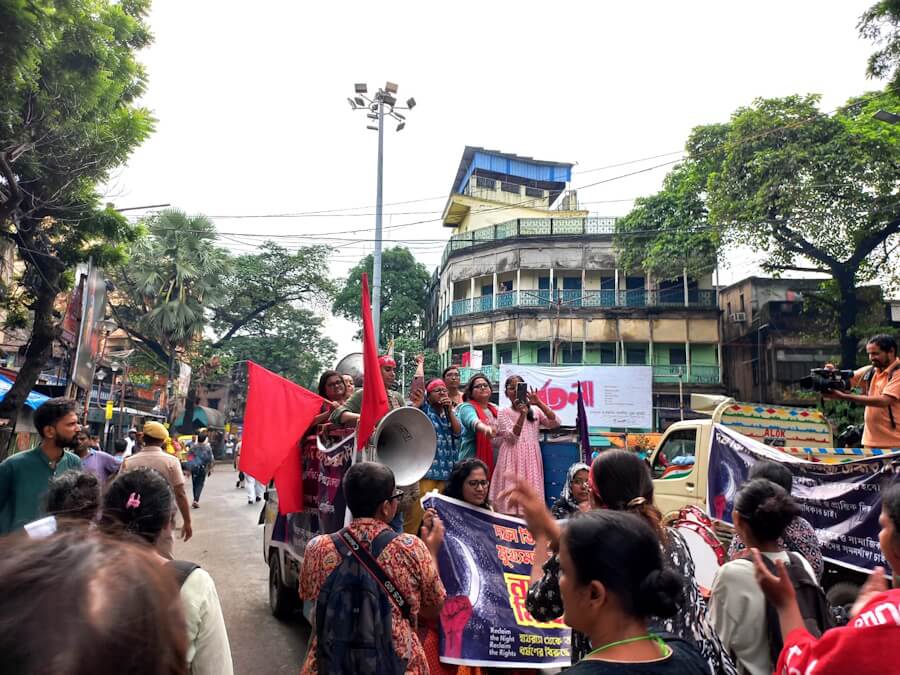
Photo: Srestha Chatterjee
So many commons, so little space
Kolkata’s ghats hold civic importance as well as ecological significance. The walks led us to observe that many ghats around Howrah Railway Station were not accessible for the disabled; other common spaces too were the same. For women and queers, they turn more complex. Bridges, including the heritage ones, are shaped for vehicular passage; we observed notices around Rabindra Sarovar cautioning vendors from using the space.
Markets, integral spaces of commons, were usually ignored as spaces of interaction and recreation though they are used in these ways. Deyasini, a participant in the walk, mentioned how the seating spaces in and around markets are zones of respite and interaction for people. Many others observed that Rabindra Sadan, an ideal civic commons, had the youth in large numbers at leisure but that all the women were accompanied by their partners. Moral police were probably around too.
Moral policing, a strict tool of behaviour control, has had a massive impact in disintegrating a community or ensuring that it stays tight-knit. Usually based on middle-class notions of hygiene, decency, and intersectional prejudices, moral policing has different meanings for different communities ranging from public display of affection and cleanliness to the presence of hawkers and people on streets disturbing aesthetics. Moral policing, as a strategy, has been used inside public transport like trains; a woman beggar, considered unwanted by society, told us how she stops fights and intervenes in harassment against women.
People in the commons
Well understood since urbanist Jane Jacobs’ work[13], the presence of people is a key factor in making the commons safer – known faces of shopkeepers, women vendors on streets, and so on. Our second walk had participants map how narrow pedestrian spaces and segregated parks for women and children made them feel unsafe, changed the atmosphere of such commons, and caused gendered ‘spatial entrapment’[14] as mentioned by Linda Peake[15] and Kim England[16]. Unseen activities and contributions by vendors, street sellers and others help to maintain and repair commons. But even the broken commons were pulsing with activity as the walking group observed in markets around North Kolkata, Ballygunge Market, Dhakuria Bus stand, and around ghats of North Kolkata. They were, to paraphrase Jacobs, ‘eyes on the street’ making us feel safer, seen, and welcomed.

Photo: Srestha Chatterjee
Lighting as urban infrastructure impacts the commons. The spaces around temples and shops with bright lights were livelier while, around the ghats, the mellow or limited lighting created a sense of eeriness and hesitation. Heritage,[17] also urban infrastructure, can facilitate communities to come together if they are active, lively, and secular spaces. A multiplicity of cultures co-exist in and around Bow Barracks and Tiretta Bazaar, as one of our walks showed, but civic infrastructure like public toilets, footpaths, and ward offices need to be well-structured. This can be possible if the community is made active participants in the imagination and construction of the commons, their stories are added as oral archives, and they are given responsibility for maintenance.
An important observation during our walks has been about the maintenance of commons and how they become part of the private – ponds reshaped into massive redevelopment projects[18] for a certain class around Itkhola in Kudghat area resulting in their gentrification, how the more gentrified Golf Green has a premium gated community guarding a pond in its backyard but how this was turned uninhabitable[19] for underwater organisms but allowed a nearby car wash service to use its water, how waste was thrown around ponds despite warnings, and how a private firm ‘bought’ the water body.[20]
The walks have brought home to us how the collective efforts of security personnel, sanitation workers, and civic volunteers make spaces safe for us, ensure that parks and washrooms are maintained, and keep them accessible. The one around Park Circus maidan made us realise the enthusiasm of people – including men – to come together to stop street harassment. While walking along Potua Para, opposite Kalighat Temple Road, we realised that the potters’ community did not feel threatened by the presence of sex workers.
Walk to further 3As
These are the engagements, observations, and interactions we seek through our walks – to initiate conversations about common spaces, de-stigmatise zones, challenge restricted access to women and queers, question the prevalent moral policing, and record how communities are, indeed, a part of the commons simply by occupying them or helping maintain them. The intention is to demystify the commons, see them through a different lens, and challenge the politics of public versus private, us versus them, everyday care versus selective care in the city.
By questioning the hetero-partiarchal demarcation of the civic commons[21], we strive to increase the 3 As of accessibility, affordability, and approachability; we question the prevailing standards of moral safety; and we examine access and reimagine means of reclaiming that access. These purposeful walks are more than loitering; they are about knowing our city, understanding how different people interact with the city and what they want it to be. A transgender person told us, during a walk, that they seek acceptance in Kolkata’s commons – simple yet so difficult.
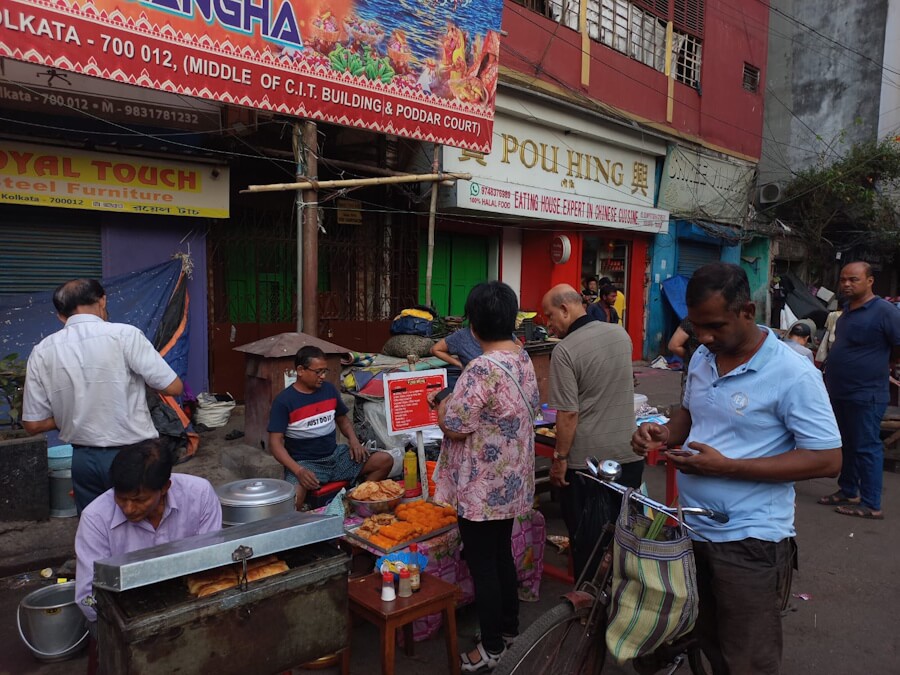
Photo: Srestha Chatterjee
Such acceptance begins when we go beyond bourgeois civility and environmentalism, as sociologist Amita Baviskar noted in Uncivil City (2024)[22]. Usually, urban ecosystems and infrastructure reflect the agenda of the accepted or ‘civilised’. Our walks, by questioning and relearning, empowers individuals and communities to go beyond the obvious tropes of planning and use of the city. And seek to mobilise their skills and resources for capacity development. The idea is to explore how people’s voices – of women and queers – are kept at the head of decision-making, as followed by the Mahila Housing Trust[23] in training Vikasinis[24] from informal settlements and empowering them to decide on their neighbourhoods (Jhabvala & Brahmbhatt, 2020).
Really reclaiming our commons, at least our streets, key actions must be collectively imagined and done: Weekly meetings at micro level, ground-level democratic discussions about street harassment and maintenance of infrastructures and commons in a non-partisan ways, bringing more urban planners and placemaking experts into our community walks, engaging schools, colleges, workplaces, or other institutions, maintaining archives of photo-narrative submissions from various parts of the city as our participants Raka and Pragati did, providing booths of ‘care for your space’ and audit offices managed and led by citizens from each area, prioritising the needs and concerns of the marginalised (waste-pickers, sanitation workers, hawkers) and everyday commuters, involving people of all socio-economic groups in planning processes.
Remaking the commons is, indeed, a tall task but even if they have to be pivoted for better access, use, safety and meaning for all people in the city, if the ideology of care and share has to replace that of privacy and profit, it is important to examine their ‘publicness’. To do this in an engaging and meaningful manner, there’s no parallel to walking in the public space. It reveals itself to us in countless ways – and helps us, the marginalised, to reclaim the commons even if sporadically.
References:
- Baviskar, A. (2024). Uncivil City : Ecology, Equity and the Commons in Delhi. Yoda Press, 2nd Edition.
- Bose, T. (2025). R G Kar rape-murder: A year later, where the cases stand. Indian Express.
- De Certeau, M. (1993). Walking in the City. In Book – The Cultural Studies Reader. Ed (During, Simon. 1993). Pgs. 156 – 163
- Holmes, D. (2011). Rabindra Sarobar | Kolkata India. WLA – World Landscape Architect.
- Jacobs, J. (1961). The Death and Life of Great American Cities. Random House, New York City.
- Jhabvala, R. & Brahmbhatt, B. (2020). The City Makers: How Women are Building a Sustainable Future for Urban India. Hachette India.
- Kumar, M. (2024). Social Impact Of Neo-Liberal Policies: Inequality And Inclusion. International Journal of Creative Research Thoughts. Volume 12, Issue 10 October 2024 | ISSN: 2320-2882.
- Menon, N. (2024). Women (Re)Public. The Third Eye Portal.
- Mitra, D. (2025). One year, no justice: Women to reclaim Calcutta’s nights with vigils, songs on I-Day eve. The Telegraph Online.
- Newalkar, R. & Wheeler, A. (2017). Ecofeminist Ethics for Sustainable Urban Public Space. The IAFOR International Conference on the City 2017 Official Conference Proceedings.
- Obad Šćitaroci, M., & Bojanić Obad Šćitaroci, B. (2019). Heritage Urbanism. Sustainability, 11(9), 2669.
- Purcell, M. (2013). Possible Worlds: Henri Lefebvre and The Right to The City. JOURNAL OF URBAN AFFAIRS, Volume36, Number1, pages 141–154.
- Schmid, C. (2022). Henri Lefebvre and the Theory of the Production of Space. London & New York: Verso.
- Singh, S. S. (2024). “Reclaim the Night”: Thousands hit streets in West Bengal to mark one month of RG Kar rape and murder. The Hindu.
Srestha Chatterjee has graduated with a Master’s in Sociology and nurtures a specific interest in urban sociology at the intersection of gender and urban planning with a keen interest in participatory planning and collaborative design. She holds monthly Gender Community Walks as part of her Pilot Research Project which aims at enquiring into the aspect of developing Feminist Cities in the Global South through a participatory, decolonised model of development.

